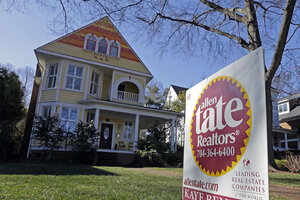Existing home sales fall to 9-month low in January, but market isn't 'hopeless'
Existing home sales fell 4.9 percent to a 4.82 million annualized pace in January, the National Association of Realtors reported Monday. Despite some worrying early results, there are hints that existing home sales could bounce back in the coming months.

A home for sale in Charlotte, N.C. The National Association of Realtors reported a 4.9 percent decline in sales of existing homes in January on Monday, Feb. 23, 2015.
Chuck Barton/AP/File
January can be a tough month for the housing market, with sales of pre-owned homes cooling right along with the temperature. Last month was no exception.
Existing US home sales fell to their lowest rate in nine months in January, according to a report released Monday by the National Association of Realtors (NAR). Sales fell 4.9 percent to a 4.82 million annualized pace, a notable drop from December’s 5.07 million rate. Economists had been expecting a smaller slide, to a 4.95 million rate. Still, sales were 3.2 percent higher than January 2014, marking the fourth straight month of year-over-year increases.
The months’ supply of homes available for sale ticked up slightly, from 4.4 in December to 4.7 in January. Sales fell in every region of the country last month, with the biggest drop coming in the West (a 7.1 percent decline).
Because of the high possibility of inclement winter weather, January is a notoriously volatile month for the housing market. But last week, new home construction and homebuilder sentiment also reported declines, despite relatively favorable conditions – aside from New England’s well-documented snow troubles, overall last month was the 24th- warmest and 18th -driest January over 121 years, according to IHS Global Insight.
According to analysts, factors beyond a few snowstorms are holding the market back. “Low housing supply and the ongoing rise in home prices above the pace of inflation appeared to slow sales despite interest rates remaining near historic lows,” said Lawrence Yun, NAR’s chief economist, in the data’s release. “Realtors are reporting that low rates are attracting potential buyers, but the lack of new and affordable listings is leading some to delay decisions.”
Indeed, despite a number of favorable developments, including an increasingly healthy job market and a slight increase in wages, affordable home ownership is still out of reach for a worryingly large swath of Americans. The already-low share of first-time homebuyers slipped another percentage point last month, to 20 percent. That lack of buyers is leading to a crush in the rental market and driving up prices there: According to January report from the Census Bureau, vacancy rates for rental housing fell to 7 percent in the fourth quarter of 2014 (near historic lows), while the vacancy rate for owned homes remained at a relatively high 1.9 percent.
Still, there are some hopeful signs on the horizon. For one, price growth is continuing at a healthy pace. The average house price increased to $199,600 – 6.2 percent above January 2014. “This figure gives a better indication of the housing market’s overall health than do sales volumes, in part because it can serve as an indicator of future activity,” IHS Global Insight economists Stephanie Karol and Patrick Newport wrote in an e-mailed analysis. “Robust price growth inspires more homeowners to list their houses for sale.
Furthermore, the Obama administration has taken steps on the affordability front. On Jan. 26, new rules went into effect, potentially reducing the Federal Housing Administration’s mortgage insurance premiums for millions of borrowers who choose to refinance. Year over year, the share of first time homebuyers has improved by 11.2 percent, and investment activity from all-cash and speculative buyers, which propped up the housing recovery in its early stages, has dwindled.
“Existing home sales are taking a bumpy road towards recovery, but all is not lost,” Mr. Newport and Ms. Karol write. “The overall picture is looking brighter than it did this time last year.”

